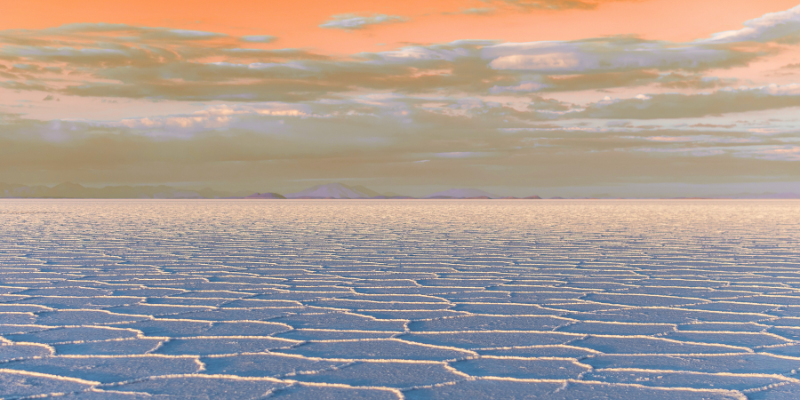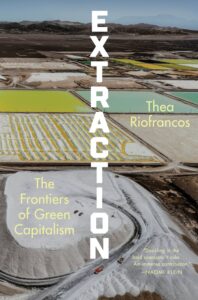
What Mining for Water in the Andean Desert Reveals About “Green” Capitalism
Thea Riofrancos on the Astonishing Biodiversity in the Atacama Salt Flat—And Why We Need to Protect It
A high-altitude desert plateau traverses Argentina, Bolivia, and Chile. I am on the Chilean side, in the passenger seat of a Jeep, along with two other researchers. The afternoon air is thin and brisk, but the sun is piercing—a combination I am familiar with from years of living and traveling in South America’s Andean range. The landscape is a study in contrasts and contours: broad basins suddenly cut off by sweeping curves, flat expanses sliced by near vertical ascents. The Licancabur Volcano looms large above us. Vegetation and humidity levels change rapidly with the rising altitude, bringing cooler temperatures, wetter air, and denser plant life. We are driving from San Pedro, once a small town but now a metastasizing tourist hub, to the Salar de Atacama, the vast salt flats that contain the largest lithium reserves in the world.
The space and time of our journey are occasionally marked by passing through one or another of the eighteen Indigenous (Atacameño, or Lickanantay) communities that ring the salt flat, each organized around one of the spring-fed streams that run down the deep ravines sliced into the slopes of the surrounding mountains. Each community has a relationship to its deified and named mountain, which a range of practices aim to appease in return for water and harvests. Local irrigation infrastructures channel this water to homes and small farms. The resulting “Mediterranean” microclimate creates fertile conditions for figs, pomegranates, quince, grapes, and maize.
I’m not sure if I’ve ever felt so buffeted by so many elements at once: the whipping wind, the sky alternately grainy with sand and sparkling with raindrops, intense sunlight barely veiled by enormous gray clouds.
We detour into the high mountains bordering Bolivia before careening back down toward the alluvial basin and the salar. En route, we pass an Atacameño family in the midst of an outdoor celebration. I buy a kilogram of fresh goat cheese, and then we take off for the salt flat.
A sandstorm, improbably though quite palpably interspersed with a rainstorm, engulfs us for most of the remainder of our drive. I’m not sure if I’ve ever felt so buffeted by so many elements at once: the whipping wind, the sky alternately grainy with sand and sparkling with raindrops, intense sunlight barely veiled by enormous gray clouds. And then, abruptly, the environment rearranges itself. The sand and sandstorm disappear, replaced by gradations of white and gray that stretch all the way to the mountains that still form the horizon.
This is the Salar de Atacama—the Atacama Salt Flat—the largest of several dozen salt flats in northern Chile and the third largest in the world, about two-thirds the size of my home state of Rhode Island. The brilliant white flat lies in a high basin 7,500 feet above sea level, enclosed by the even higher Andean Mountains to the east and the Domeyko Mountains to the west. We park and enter Los Flamencos National Reserve, 285 square miles of protected ecosystem, by foot. It is extremely dry and the solar radiation extremely high (the day we visited the UV levels were literally off the charts).
To our left stretches unending salt crust. To our right, the crust is interspersed with lagoons. But the landscape is not all gray and white. Upon closer inspection, elegant Andean flamingos with pastel pink feathers are backed by the muted red water of the lagoons, an effect produced by the interaction of algae, sun, and wind.
This striking landscape—the salt flat, the flamingos, and the neighboring Indigenous communities—is under threat from a counterintuitive source: our efforts to save the planet from catastrophic climate change. Just beneath my feet are nearly one-third of the world’s lithium reserves, suspended in water saltier than the ocean. Lithium is essential to addressing the climate crisis. It is a key ingredient in the rechargeable batteries that play a starring role in eliminating carbon emissions from transportation and energy—the two highest emitting sectors. But extracting this lithium will come at escalating social and environmental costs. It is this dilemma that has brought me to the salt flat.
The Atacama is the world’s oldest desert. The high-altitude, bone-dry landscape, with its dazzling days and spectacularly starry nights, formed twenty million years ago. And despite forbidding conditions, humans began living in the Atacama at least eleven or twelve thousand years ago. Nor were they isolated. The Andean plateau long enabled north-south movement, and by at least fifteen hundred years ago, the settlements of the plateau had become intensively linked by networks of trade and travel across the Domeyko Mountains’ passes with those of the more hospitable Pacific coastal plain.
But those more interested in the region’s minerals than its people or ecology have repeatedly declared it to be empty and lifeless. The narrative penned by Spanish historian Jerónimo de Vivar, who accompanied the conquistador Pedro de Valdivia in the 1540s, painted an enduring portrait of the landscape as “barren” and “unpopulated,” except for the valleys. In all of this expanse, he wrote, “it does not rain.” The winds were frigid, the risk of death by thirst palpable.
Accordingly, Vivar called the vast space “el gran despoblado.” In Spanish, the word despoblado is ambiguous. It can mean simply unpopulated, or it can mean depopulated, implying a change over time. A deserted desert, in other words.
Abundant in resources—but supposedly devoid of life. Wealth, free for the taking, with purportedly no one and nothing harmed in exchange.
To the Spanish, this imagined emptiness justified their colonial domination. After independence in 1818, Chilean authorities appointed experts to explore and map the region and to assess the desert’s “economic potential”—specifically, its “mineable wealth.” They reproduced the tropes of colonial conquest, emphasizing the same extreme aridity, hostility to life, and emptiness. They urged the state to provide support for private firms to exploit the riches of this ostensible terra nullius—and it did.
Government policies encouraged resource extraction, which then incentivized more government support, in an accelerating cycle. In 1858, because of the discovery of copper nearby, the government declared the fishing village of Taltal a state harbor. Railroads would later link it to new inland nitrate mines, confirming it as the coastal logistical hub of multiplying extractive spokes. The state built an elaborate system of wells and pipelines to provide crucial water access for mining operations. The legal infrastructure of Chile’s Mining Code of 1874 further facilitated the private appropriation of subsoil wealth.
By the late nineteenth century, silver, gold, copper, and nitrate production was booming. Over a century later, the state still depends on the revenues generated by mining and is looking toward its next resource boom.
Today the Atacama Desert is best known as an extractive frontier, rich in two minerals key to the energy transition: lithium and copper. Abundant in resources—but supposedly devoid of life. Wealth, free for the taking, with purportedly no one and nothing harmed in exchange. State and capital, scientists and maps, minerals and water, laws and property rights, pipes and ports . . . and narratives that erase thousands of years of human habitation and flatten a complex ecosystem into a lifeless blank slate. This is how extractive frontiers are made.
When it does rain in the Atacama, it’s hard to overstate the intensity of the floods. I once found myself caught in what is called invierno boliviano, or Bolivian winter, a paradoxical name for a weather phenomenon that occurs during the Southern Hemisphere’s summer months. These rainy fronts originate in the Amazon and travel up the steep slopes of the Andean Mountains, where Bolivia’s high-altitude winds then drive them up and over the ridges, until their torrents drench the Chilean high plateau.
Rainbows were the first sign that precipitation was making its way toward us. I was on a guided trek with a group of tourists, walking on the path along a narrow ridge in el Valle de la Luna (the Valley of the Moon), trying to keep from falling over the steep cliffs on either side while gazing up at the deep red, undulating mountains and impossibly smooth sand dunes. Suddenly, multicolored banners appeared in the sky, one after the other, tracing myriad arcs from peak to peak. There were so many rainbows, I lost track trying to count them. The enchantment was dizzying.
But by the time we had driven back to San Pedro de Atacama, the landscape was shrouded in rain. Our preparations for the dry heat, our sunglasses and water bottles, suddenly seemed absurd. The town itself was submerged in darkness—the rain and winds had cut the power supply. We ate by candlelight, still shivering in our damp clothes.
The morning’s light revealed the damage. All roads south of Toconao, an Atacameño village 20 miles from San Pedro, were closed. The desert grasses of the alluvial plain to the left of the road, like the jaunty tufts of gold-green paja brava, were completely submerged. The water, made dark by the sediment it carried, was still rushing past, even though it was no longer raining.
My plans to visit a lithium mining operation foiled by the flooding, I entered Toconao instead. The river running through the town was the main attraction. Here, high up on the Andean plateau, rivers form the centerpieces to ancestral irrigation systems. They are literal oases: You can spot a village from miles away by the cluster of green trees standing out against the otherwise muted tones of the surrounding landscape. On that day, the river ran so high, swirling with white rapids, that the residents had closed all the town’s locks to protect farm plots from flooding.
The scientific term for closed basins like the Atacama is “endorheic” (etymologically, “inside” and “flow”) for water can flow down into the Atacama basin, but it cannot leave—except by evaporation. And this is the key to Atacama’s extraordinary lithium brine.
After deluges like the one I experienced, water pours down the surrounding mountains; during the long dry spells between storms, it trickles down ravines from the precious mountain springs. As it flows, the water leeches lithium from the volcanic rock, picks up wind-scoured lithium dust, and carries it down to the nucleus, or center, of the salar. This pooled surface water can only escape through evaporation, and with every drop of water that evaporates, the concentration of lithium in the remaining brine increases. Without the parched and sun-blasted Atacama’s extraordinarily high evaporation rate, lithium concentrations would not reach the “economical” levels prized by mining companies.
Everywhere that mines are dug up to provide raw materials for the energy transition, global climate action comes into conflict with local environmental protection.
Yet further lithium enrichment takes place out of sight. Remaining water gradually seeps into the ground, creating underground wells of lithium-rich brine. These wells are linked into complex hydrothermal systems. Then the heat of magma, especially near the Andes’ active fault lines, drives circulations of subsurface brine through fissures and porous geological strata, dissolving even more lithium out of the subsurface rock.
The resulting brine deposits anywhere from 4 to 200 feet below the Atacama’s salty crust represent a potential bonanza to corporations. The Atacama’s singular coincidence of climactic, geological, geothermal, and hydrological conditions makes it one of the least expensive places on earth to mine lithium.
And at each step, the process of “mining water” is intimately related to the very environmental conditions that formed the valuable deposits in the first place: Miners pump the underground brine to vast evaporation ponds on the surface, where natural evaporation concentrates the brine yet again, increasing its lithium levels fortyfold from approximately 0.15 percent to a whopping 6 percent. One cycle of the process can take ten to twenty-four months, depending on brine quality and weather conditions.
Two of the world’s largest lithium miners, SQM and Albemarle, tout this extraction method as “environmentally friendly” and “sustainable.” Official corporate statements celebrate that compared with hard rock mines, such as Western Australia’s spodumene deposits, “brine production is a very eco-friendly way to produce lithium,” with a “very low CO2 footprint” and using “very few [sic] freshwater.”
But this relatively low-cost, low-tech, and supposedly low-impact extractive process nonetheless imperils the species and communities that call the Atacama Desert home. And it is a microcosm of a planetary phenomenon: the expanding extractive frontiers of green capitalism. Everywhere that mines are dug up to provide raw materials for the energy transition, global climate action comes into conflict with local environmental protection.
Mining always transforms, in many ways irrevocably, the landscapes in which it occurs. In remaking the earth in the image of extractive capital, physically and chemically separating what is deemed valuable from often toxic waste, mining evokes the image of terraforming so central to science fiction.
But if terraforming is supposed to make a lifeless planet as verdant as Earth, mining, to the contrary, often leaves parts of the Earth itself uninhabitable. While the environmental impacts of mining brine are less obvious to the naked eye than, say, mountaintop removal, extracting the lithium-rich liquid does in fact threaten a fragile, desert water system, along with the ecosystems and people that depend on it.
The anthropogenic reshaping of nature is complex when the deposit in question is fluid. Unlike traditional hard rock mining, mining water rearranges both the brine deposits at the center of the salt flat and the freshwater aquifers at its perimeter. Pumping brine on an industrial scale creates a cone-shaped subsidence around each extraction well.
Extremity stimulates nature’s creativity.
As a result, freshwater at the salar’s perimeter flows toward its center, away from the aquifers between the foothills of the towering mountain ranges and the edge of the vast salar. Meanwhile, precipitation replenishes those vital freshwater sources very slowly. A recent study found that nearly all the freshwater stored in aquifers is at least sixty-five years old.
There is active scientific debate about precisely how much lithium mining reduces freshwater availability in the Atacama. But even those researchers who are most sanguine about the impacts of the lithium industry admit that current legal freshwater allotments to mining and agricultural companies have little basis in hydrological reality.
Even though copper mining and agriculture consume much more freshwater than the lithium sector, side-by-side comparisons of the consequences of each use of water obscures the simple fact that all three are happening simultaneously in the Atacama, constituting a direct threat to water access in the driest desert on earth—with severe consequences for the eighteen Atacameño communities that ring the salt flat.
The world’s oldest, driest desert may appear bereft of life. Ecologists call it a “polyextreme” environment, given its altitude and high direct solar radiation, its intense aridity, its huge diurnal temperature swings, and its densely saline lakes. Those who study such polyextreme environments alternately describe them as low-diversity, with relatively “simple” webs of life, or “astonishing” in their biodiversity. It all depends on perspective. Plants and animals have evolved to make do with less and saltier water and, above all, the abundant energy of relentless sun. Extremity stimulates nature’s creativity.
Artemia, or brine shrimp, thrive in hypersaline lakes that would be intolerable to most species. These tiny creatures are a key node in the plateau’s food chain. The brine shrimp eat bacteria and phytoplankton (microscopic plants) and are, in turn, food for Chilean flamingos. The flamingos, too, have adapted to the saline lagoons, evolving a filter in their bills akin to the lamellar membranes of oysters or whales to strain the microscopic plants and animals from the brine. The relationship isn’t just one of predator and prey. The tiny crustaceans cling to the flamingos, hitching a ride as the birds migrate and thus dispersing themselves across the myriad salty lakes of the Andean plateau.
For plant biologists concerned about global food security, the Atacama is a “genetic goldmine.”
The flamingos are a barometer of wetland health. As the birds travel the salt flats in search of food and mates (attracted through a courtship ritual of synchronized dancing), they link together the saline lakes into a web of habitats. And as these habitats suffer, so do flamingo populations: All three of the Atacama Salt Flat’s endemic flamingo species are in decline.
The distinct drivers of this population loss reveal the compounding harms afflicting this fragile environment. Warmer average temperatures due to climate change evaporate surface water faster, reducing the blue-green algae essential to flamingo and Artemia diets. And the noise and traffic associated with mining operations appear to directly disrupt the flamingo’s breeding.
Though less charismatic than the improbably pastel pink birds, unique endemic plants have achieved impressive feats of resourcefulness and endurance. Indeed, scientists have called the region an “unparalleled natural laboratory” to understand how plants adapt to “extreme environmental conditions.” Species like Solanum chilense, a wild desert tomato, or the flowering Azorella atacamensis, with its anti-virulent properties, cope with high solar radiation and frigid nights and can likewise survive prolonged droughts punctuated by intense rains. Given the desert soil’s limited absorptive capacity, much of the rain runs off in flash floods, offering the plants only a short and unpredictable window to quench their thirst.
These plants of the Atacama, whether wild or domesticated, tell stories. One story is of human knowledge accumulated across millennia, enabling communities to cultivate sustaining harvests in a hostile environment. Another is of the origins of organic life on earth—and its possibility on other planets. And another is how aspects of our future may be prefigured in the desert’s past. The very conditions that these plants have evolved to withstand are more and more common the world over.
As humanity faces a warmer and drier future, researchers are exploring whether relatives of the staple crops able to thrive in Atacama, like legumes and potatoes, might help feed future generations in a hotter and more arid world. For plant biologists concerned about global food security, the Atacama is a “genetic goldmine.”
The Atacama offers access to other realms of knowledge as well. Its vast and austere geometries, its mountains and basins, valleys and ridge lines, its craggy textures, and its palette of gray and white and red and brown conjure up the landscapes of the moon or Mars.
But its link to other worlds is not just a poetic analogy. Atop a ridge 5,000 feet above sea level, far from any light pollution, through the moistureless air, the world’s largest astronomical project, the ALMA (Atacama Large Millimeter/submillimeter Array), has an unparalleled view of the galaxy.
And, out of view, there is yet another real alien world in the hypersaline lakes and subsurface brine deposits of the Andean plateau. These are liquid habitats for the captivating microorganisms classified as “extremophiles”—literally, lovers of the extreme, because of their ability to withstand salty water, parched air, and relentless sun.
Science can only play catch-up, documenting the impacts long after the harm has occurred.
The very existence of these bacteria upend prior scientific assumptions about microbial habitats and deepen our understanding of biological evolution on earth—and of the possibility of life on other planets. Such organisms were at the origin of the earth’s evolutionary history, and they in turn propagated yet more life, enabling oxygenation and helping cause what evolutionary biologists call a “biodiversity explosion” 2.5 billion years ago. In this sense, the salt flats and their salty lakes are at once a living record and an ongoing recapitulation of billions of years of planetary history.
In the lithium-rich brine deposits far below the desert surface, one of the saltiest environments on earth, single-celled archaea predominate. Without access to the sun, they generate energy from inorganic chemicals in a process known as chemosynthesis, rather than the more familiar photosynthesis.
Amazingly, this life can still be found in the dense, super salty water even once the brine is pumped to the surface. But the pumping and evaporation of brine fundamentally alters its microbial profile, allowing bacteria to overgrow the archaea. Some scientists have therefore called for a “framework of conservation” to protect the bacteria and archaea that are lithium’s neighbors.
Researchers are struggling to predict the overall direction of the multiple compounding and confounding processes changing the Atacama. Global warming leads to faster rates of evaporation of water in the surfacing lagoons, making their salinity more than species had originally evolved to withstand, at the same time that lithium mining’s rapid pumping up of brine draws freshwater from aquifers into the subsurface brine, reducing its salinity. Science can only play catch-up, documenting the impacts long after the harm has occurred. Lithium extraction’s threat to the liquid supporting its ecosystem is a slow-motion disaster with planetary causes and consequences.
Mining companies typically portray brine as lacking any environmental value. Yet scientific research has revealed that the brine is not only an essential constituent of the plateau’s broader ecology, but an entire ecosystem unto itself. This fact raises existential questions for the planet’s zero-carbon future.
In the Atacama, global supply chains intersect with local food chains, webs of economic production undermine webs of life, and colonization and postcolonial state-building erase ancient histories of continuous Indigenous settlement. And these unexpected entanglements are just the beginning of the story. In more ways than I could have imagined when I first stepped foot on the Atacama Salt Flat on that blustery day, this extractive frontier is a portal into our planetary future.
__________________________________

Excerpted from Extraction: The Frontiers of Green Capitalism. Copyright © 2025 by Thea Riofrancos. Used with permission of the publisher, W. W. Norton & Company, Inc. All rights reserved.
Thea Riofrancos
Thea Riofrancos is a political science professor at Providence College, and Strategic Co-Director of the Climate and Community Institute. Her research has been featured in essays in The New York Times, The Washington Post, N+1, and The Guardian. She lives in Providence, Rhode Island.












